Sago palm care is easy. It is one reason why Cycas revoluta are excellent plants for inexperienced gardeners.
The sago palm (its common name) grows as a landscape plant across the southern states but is also used as an indoor house plant.
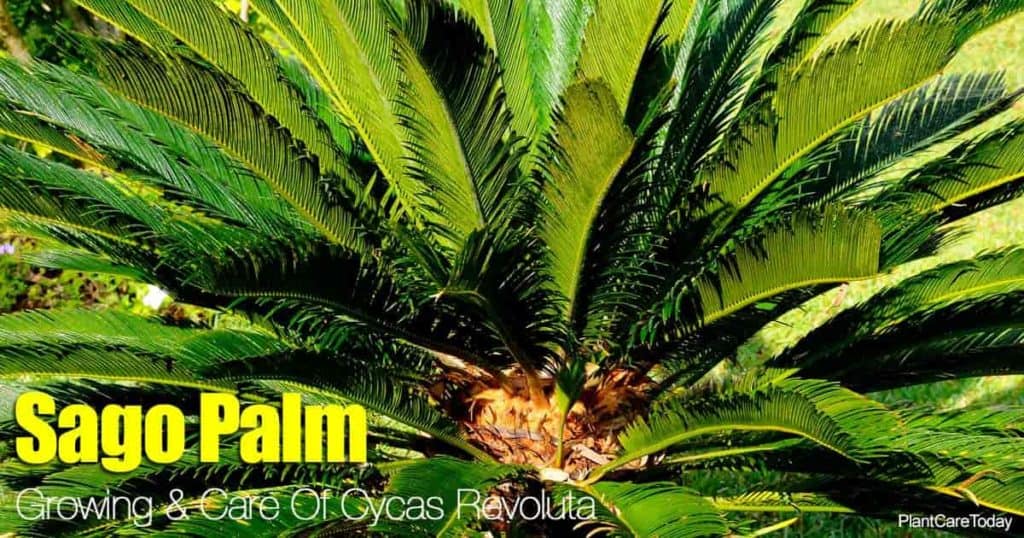
Commonly called the “sago palm” or “king sago palm.” They resemble a palm, like a ponytail palm – but are not a palm. Cycas revoluta is a cycad from the family Cycadaceae.
The sago palm plant produces cones and bears attractive, palm-like feathery foliage making it very similar looking to palms, and tree ferns.
Known as prehistoric plant, the sago provides strong natural defenses against predators. It also adapts to a wide variety of conditions.
Take care if children or pets like dogs tamper with the sago plant as the leaves are toxic if ingested. Make sure you have the animal poison control center number handy.
Cycas Revoluta Care
Cycads generally prefer very bright light but will tolerate low light. They prefer staying on the dry side as excessive watering leads to rotting roots.
Indoors or out, the palm sago prefers a light, well-drained soil with ample sun.

With minimal care, these rugged “palm trees” can last a lifetime and then some.
Slow-growing and long-lived your sago palm may not bloom (produce a cone) in the first 15 years of its life or ever at all.
Sago Topics You May Like:
- Sago Palm Flowering and Cutting Off Sago Palm Flower Heads
- What Is The Best Soil For Sago Palms
- Sago Palm Watering
The cycas revoluta periodically produces a lovely new flush of foliage called “break”. This compensates for its slow-growing habit.

These tender young leaves emerge all at once in a crowning, circular or feather-like rosette pattern.
Several weeks later, the leaves become harder, and stiffer. When the sago palm reaches the reproductive stage, the semi-glossy green leaves have strong recurved edges.
Keeping Your Potted Sago Palm Healthy
Grown outdoors, the sago palm is hardy in USDA zones 8b – 11. But, they make ideal indoor potted ornamental plants as well as sago bonsai plants and can stay indoors in any region all year round.

Check out these tips for successful Sago Palm indoor care as a potted house plant.
- Keep plants in an area that gets plenty of bright indirect sunlight. The room temperatures should remain around 75° degrees Fahrenheit throughout the day. Nighttime room temperatures should stay between 65° and 75° degrees Fahrenheit.
- Protect Cycas revoluta from hot or cold drafts. Don’t place it too close to a window or a cooling or heating vent. Place the plant five and eight feet away from very sunny windows. This will protect the plant from excessive, burning sunlight.
- Place plants out of high traffic areas to protect their leaves from breakage.
- Turn the plant a quarter turn every couple of weeks throughout the year except for in the spring. In the early spring when new leaves begin to grow, simply let the plant sit.
- Check the moisture of the potting mix once a week by poking your finger into the top two or three inches. If the soil is dry, water the plant thoroughly. If it is still moist wait a few days and check again.
- Empty the drip tray under your plant after you finish watering. Don’t allow your sago palm to stand in water because this will lead to root rot. Providing higher humidity levels is helpful.
- Fertilize your plant when watering using an 18-6-18 water-soluble plant food. Mix one teaspoon of fertilizer into a gallon of water for proper dilution during the growing season. Start in the springtime when you see new growth. Stop fertilizing in mid-fall, and do not fertilize throughout the winter.
- Check plants once a month and trim any yellowing or dead leaves and dust the fronds with a soft cloth. When you prune dead growth, be sure to prune it close to the trunk. Use a sharp, clean set of pruning shears.
- In the springtime when new growth appears, check to see if the plant is root bound. If the plant and roots seem crowded in its current container, you will want to consider transplanting sago palms. Select a pot two inches larger than the pot your plant currently grows in. It goes without saying that it must have good drainage holes in the bottom.
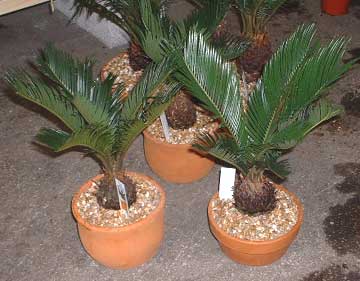
Caring For Cycas Revoluta Outdoors In The Landscape
Of course, if you like, set your potted Cycas outdoors in a sheltered area during temperate times of the year. In USDA hardiness zones 8b-11, the Sago palms can live outdoors year-round.
In an outdoor setting, planted in the ground after many years plants can grow to a height of 10′ feet tall!
In the landscape, the sago provides an “Oriental Influence”. Here is how one designer described using the sago revoluta in their landscape plan…
The Japanese lantern mounted on a pedestal, with pleasing freeform lines, was carved from lavarock (feather stone one of the many types of landscaping rocks available). Dramatic growing Cycas revoluta (Japanese sago palm) among coral boulders makes an interesting background.
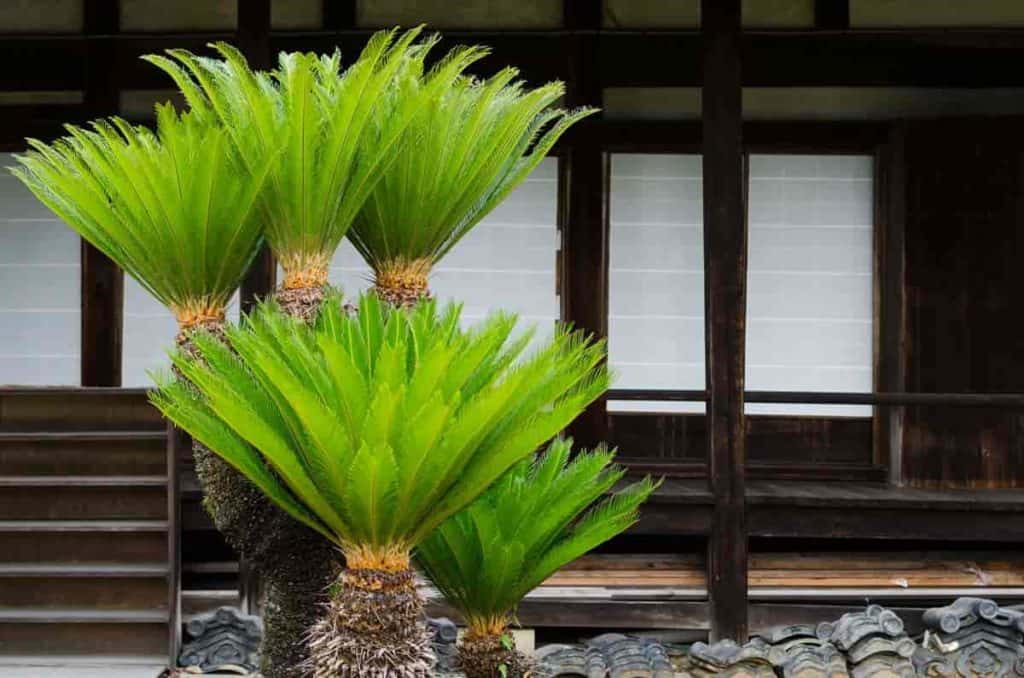
Light & Temperature
Cycas revoluta loves bright light and full direct sunlight, but it’s possible to have too much of a good thing.
In areas with very hot, punishing direct sunlight it’s best to place your Cycas revoluta in an area that gets good morning sun and light afternoon shade.
Watering and Fertilizing
As always the sago palm needs an area with good drainage. Just as with potted sago, soggy soil can cause rotting roots.
Light, airy outdoor soil amended with compost or other organic matter works best.

When first planted, keep your sago palm fairly well watered. Water deeply about once a week. Be sure to moisten the top foot of soil.
Once your plant is established, it will require limited watering even in direct sunlight. Watch for signs of distress and water deeply if you begin to see wilt.
Sago Palm Fertilizer – Once A Year
Outdoors, plants will require less fertilizer. Apply a slow-release fertilizer or a palm fertilizer in the springtime.
Apply it around the base of the plant, approximately eight inches away from the trunk. Water thoroughly after application.
Annual fertilizing should be enough, but unusual yellowing of the leaves may indicate your sago palm is suffering from magnesium, potassium, or other nutrient deficiency.
In this case, apply a chelated iron or Epsom salt spray to the leaves to the foliage. This will not undo the yellowing of older foliage, but as new leaves grow, they should be a nice healthy shade of green.
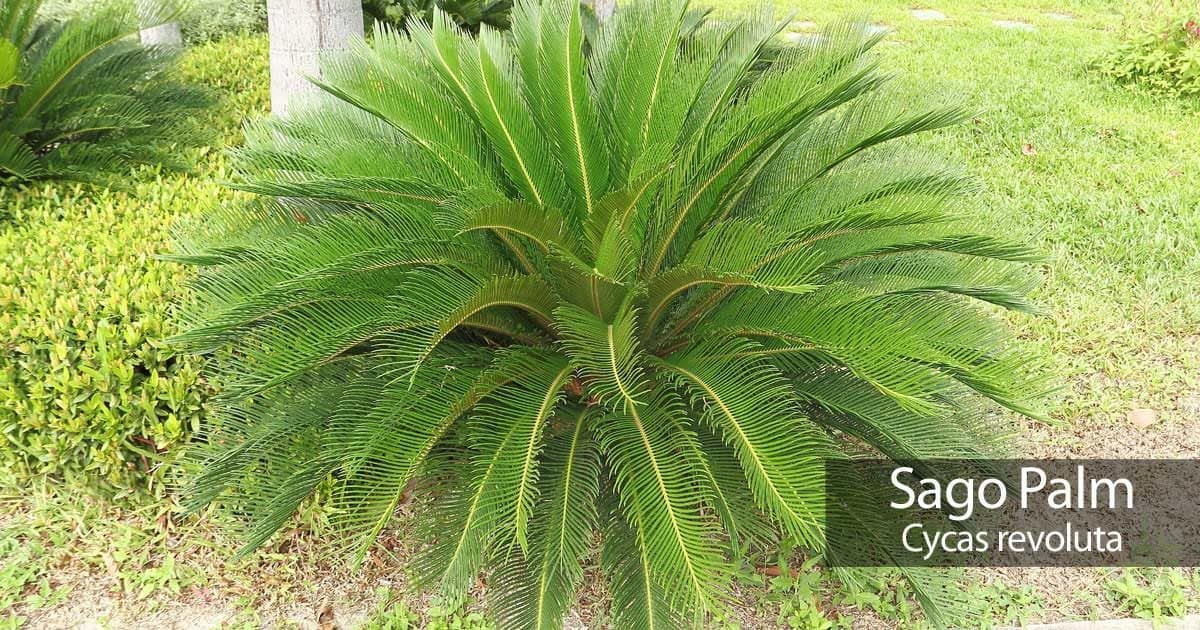
How To Repot Your Sago Palm
Once you select a new pot, place a couple of inches of gravel in the bottom. This facilitates good drainage and keeps the soil from sifting through the holes. Be sure to have plenty of light, well-draining potting mix on hand.

- Carefully remove the plant from its existing pot. You may need to loosen it a bit by sliding a spade or knife blade between the edges of the soil and the sides of the container. Once loosened, slide the plant out of the container. Don’t pull the plant out.
- Lay the plant on a base of newspaper and massage the roots to spread and open the soil ball.
- Put enough potting soil into the pot to bring the top of the root ball to within a couple of inches of the top of the pot. Set the root ball into the pot and fill in the space around it with fresh potting soil.
- Tamp the potting soil down firmly and add more potting mix until you fill the pot to a soil level even with the top of the roots. Water the plant thoroughly, and pour the water out of the drainage saucer when done.
Collecting And Moving Sago Palm Cycas Revoluta
Growers collect old “stumps” since these slow growing large sago palm specimens can be regrown.

The stumps pictured are decades old and collecting stumps, digging and moving slow-growing cycads can be a very taxing task.
The long and fibrous roots of revoluta can cause trouble.
In fact, some grounds, walls, and concrete pavements crack due to the underrated power of the intertwining strands of roots that comprise the root system.
Also, the plants or “stumps” can become damaged. Take care when collecting them.
Grooming And Maintenance
How To Care For Sago Palms In The Winter
If your location endures short cold snaps, your sago palm will probably not suffer much harm. These tough plants can withstand very low temperatures (e.g. 15° degrees Fahrenheit) for short periods of time as long as you provide some protection.

Steps For Winterization
In areas where the temperature becomes cold but not freezing:
- Cut back on your watering in the wintertime and allow the plant to go semi-dormant.
- Late in the fall, prune off dead growth and mulch heavily (approximately three inches) around the roots to protect them and conserve moisture throughout the winter.
- During the winter months, when you expect freezing temperatures, provide your plant with protection by covering it with a blanket or burlap bag to prevent freezing.
- Uncover it when temperatures rise above the freezing point.

Even with this care, your cycad will probably suffer some dead leaves through the wintertime.
- When spring arrives, cut back any dead foliage, fertilize and get ready for new growth.
- In areas that remain very cold for extended periods of time, you will need to bring your potted sago palm indoors for the winter.
- Remember, overwintering Cycas revoluta is different than keeping a houseplant year-round.
- When overwintering, you want to keep the plant in a cool area with indirect bright light.
- Water sparingly as the plant will go into a dormant state throughout the winter months. Don’t fertilize during this time.
How To Trim Sago Palms
Naturally, you will want to trim off yellow leaves as described above. If your plant produces a cone, you will eventually want to remove it as it begins to break apart.
Do this carefully and avoid damaging the growing point underneath it.
How To Propagate Sago Palm
Cycads propagate in several ways, from seed, bulbs, or sections of trunk. All are slow-growing.

Sago palms have male and female plants. The male cone produces pollen which fertilizes the female cone where the seeds are then produced.
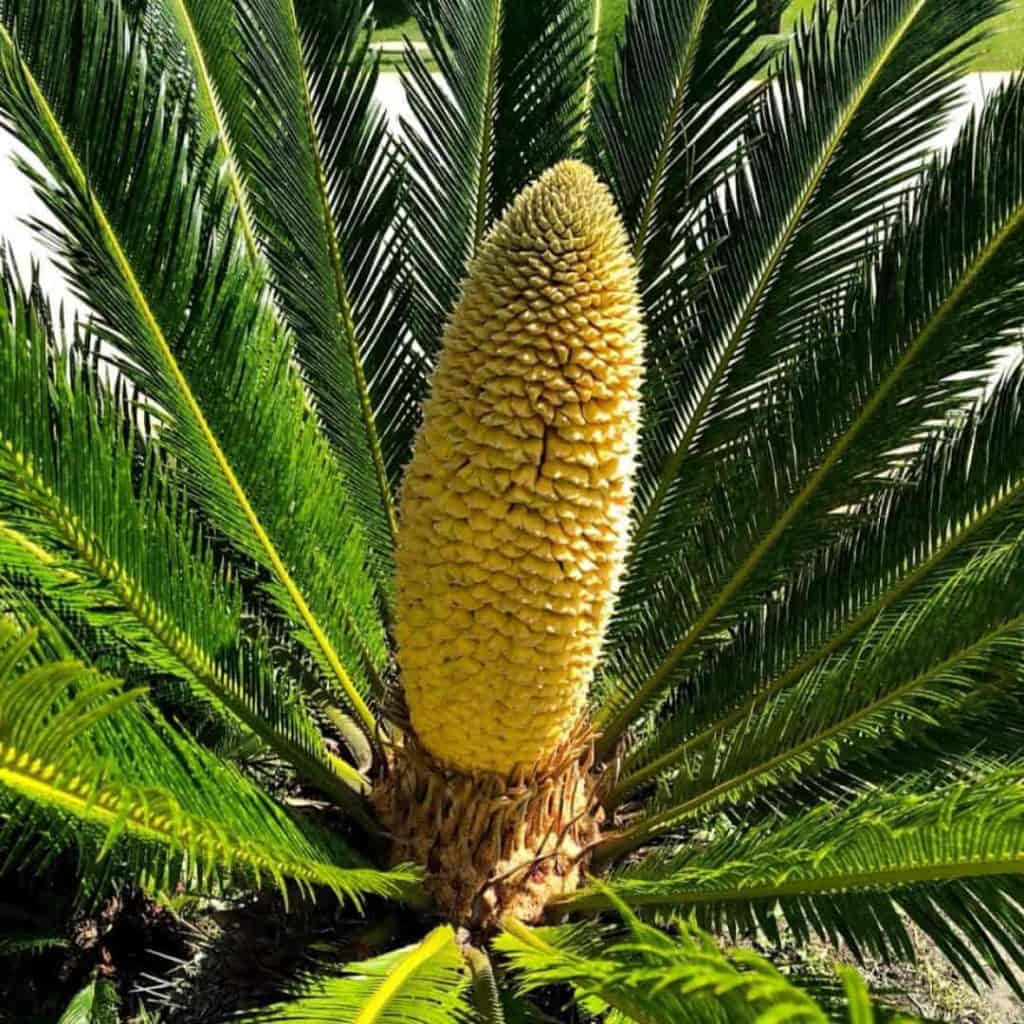
How To Plant Sago Palm Seeds
Sow ripe seeds in a shallow flat or pot with a soil mixture containing lots of sand.
Keep temperatures in the high 70’s. Months can pass before tiny shoots begin to show on new plants, and another 3-6 months or more before seedlings can be moved or repotted.
Side Shoots Sago Bulbs or Pups
Old mature plants sometimes develop bulbs or side shoots on the stem. These bulbs can be cut off the parent plant and rooted. Remove leaves from the side shoots as they pull lots of moisture.
Stick the “bulbs” in soil (I like pure sand) keeping the mixture on the dry side until new roots form over a few months.
More Sago Topics You May Like:
- How To Choose the Best Sago Palm Fertilizer
- How To Plant and Grow Sago Palm Seeds
- Splitting and Dividing Sago Palm Pups
Section Of Trunk
Just like the “bulbs” or side shoots, sections of sago trunks can be planted. This is often done with “collected” plants.
No matter what propagation method selected, it is a time-consuming, slow process and for many difficult.
Seed germination takes many months, their growth rate is slow, and growing them to size takes many years.
Sago Pests or Diseases
Indoors or out, Sago palms are generally problem free. However, mealybug does attack them. But the worst pests outdoors on sago plants is plant scale bugs and particularly Asian cycad scale insects.
Read this article on how one nurseryman uses coffee grounds for pest control on Asian scale bugs and other cycad pests.
As for Sago diseases, the only problems I’ve experienced with a fungus or rot started with a wound to the trunk.
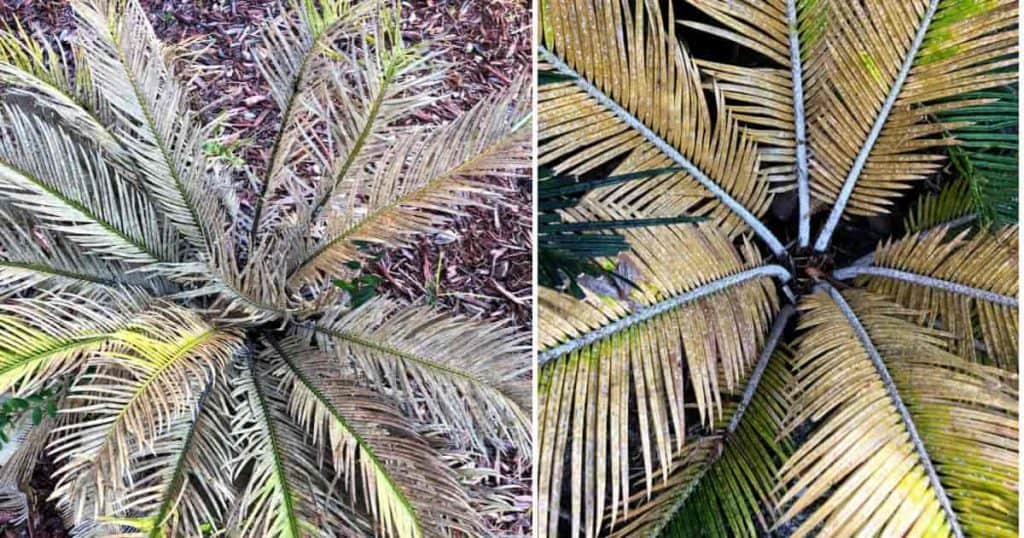
Common Maladies of Revoluta Cycads
Because of its strong natural defenses, these are fairly trouble free plants. If you provide ample light, well-drained soil, light watering, occasional fertilizing, and a new pot every couple of years your plant should go along happily for a very long time.
Of course, some problems may arise. One of the most common is the sago palm turning yellow. As with any other type of plant or tree, when leaves become old they turn yellow, then brown before falling off.
To avoid a scruffy appearance, trim the leaves or fronds back to the base when they begin to yellow. This will make room for fresh new leaves.
If trimming does not resolve this problem, or if yellowing appears on new growth, it may be an indication of some other problem, such as:
- The need to fertilize more frequently. Be certain you fertilize using the right amount of a balanced fertilizer.
- Look for a pest infestation (e.g. plant scale). If you find pests on your sago, pick them off my hand or address it using natural sprays of neem insecticide oils or beneficial insects.
- Check to see if you’re watering too much, or the soil does not have efficient drainage. If this is the case, you may need to repot your plant, if outdoors, amend the soil around it.
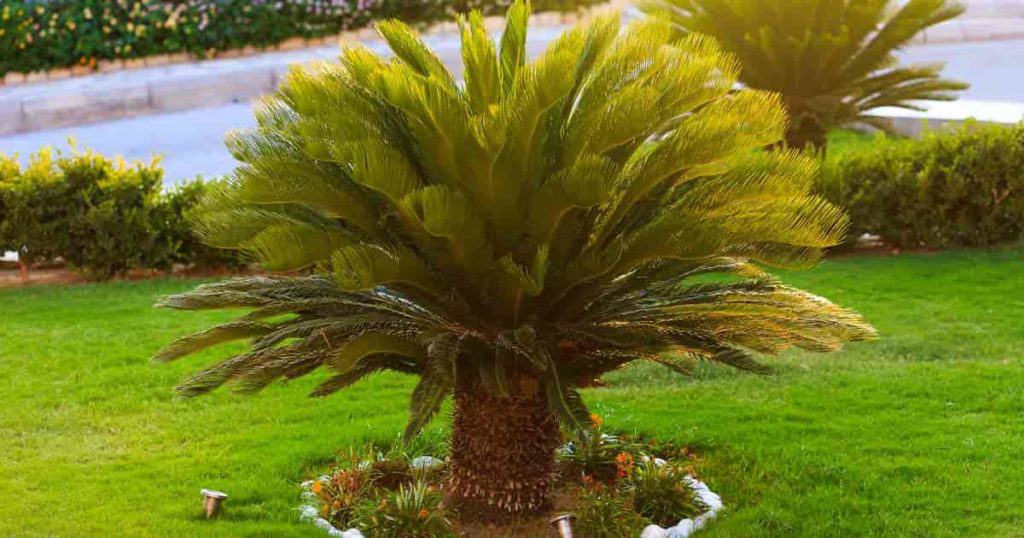
Sago Palm Buying Tips
You’ll find the king sago palm for sale in many big box garden centers being sold as a “dwarf palm.” Since sago palms do not have a real “season,” purchase them at any time of the year.
Some stores may offer for sale potted sago in 3-gallon pots.

Larger sago palms used and planted in the landscape are available from landscapers. The plants are heavy and difficult for the average homeowner to handle.
When buying a Sago palm look for foliage with clean undamaged leaves and dark green foliage.
In the landscape or as a houseplant the easy to grow Sago Palm is a versatile addition.
Less Is More
Cycas revoluta should be a fairly foolproof type of plant for most gardeners. Unfortunately, many people simply overdo when it comes to sago palm care.
Extremes of temperature, excessive watering, and too much sun are enemies of cycads.
If you can remember to provide steady temperatures, light watering, and moderate bright light, you can look forward to enjoying success with Cycas Revoluta.
